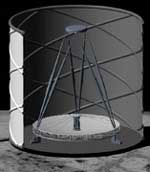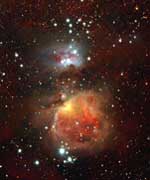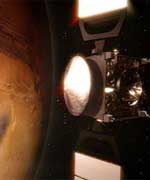
Image credit: University of Arizona
Over 30 years ago, Dr. Roger Angel came to the University of Arizona, drawn by the favorable conditions for astronomical observing in the Tucson, Arizona area: several telescopes are conveniently nearby, and of course, the weather is wonderfully temperate. But now, Angel proposes to build a telescope in a location somewhat more remote and not quite so balmy: a polar crater on the moon.
Known for his innovations in lightweight telescope mirrors and adaptive optics, Angel now leads a team of scientists from the U.S. and Canada who are exploring the feasibility of building a Deep-Field Infrared Observatory near one of the lunar poles using a Liquid Mirror Telescope (LMT).
This concept is one of 12 proposals that began receiving funding last October from the NASA Institute for Advanced Concepts (NIAC). Each gets $75,000 for six-months of research to make initial studies and identify challenges in development. Projects that make it through the first phase are eligible for as much as $400,000 more over two years.
LMTs are made by spinning a reflective liquid, usually mercury, on a bowl-shaped platform to form a parabolic surface, perfect for astronomical optics. Isaac Newton originally proposed the theory, but the technology to actually create such a device successfully has only recently been developed. Just a handful of LMTs are being used today, including a 6-meter LMT in Vancouver, Canada, and a 3-meter version that NASA uses for its Orbital Debris Observatory in New Mexico.
On Earth, LMTs are limited in size to about 6 meters in diameter because the self-generated wind that comes from spinning the telescope disturbs the surface. Additionally, like other Earth-based telescopes, LMTs are subject to atmospheric absorption and distortion, greatly reducing the range and sensitivity of infrared observing. But the atmosphere-free moon, Angel says, provides the perfect location for this type of telescope while supplying the gravity necessary for the parabolic mirror to form.
The potential of an LMT on the moon is to make a very big telescope. For reference, the Hubble Space Telescope has a 2.4 meter mirror, and the James Webb Space Telescope (JWST) being developed for launch in 2011 will have a 6 meter mirror. The concept for Angel’s NIAC proposal is a 20 meter mirror, but with the research the team has done so far, they are now looking at creating very large mirrors, with 100 meters being the big end option. They are considering smaller LMTs as well. “We obviously can’t go to the moon and make a 100 meter mirror the first thing,” Angel said. “We’re looking at a sequence of scale sizes of 2 meters, 20 meters, and 100 meters, and are looking at what the potential is for each one.” Angel believes the 2 meter telescope could be made without any human presence on the moon, and set up as a robotic telescope, much like the scientific instruments on the Mars rovers are operating now.
The limitation of a liquid mirror is that it only points straight up, so it’s not like a standard telescope that can be pointed in any direction and track objects in the sky. It only looks at the area of sky that is directly overhead.
So, the scientific goal for a LMT is to not look over the whole sky, but to take one area of space and look at it intensely. This type of astronomy has been very “profitable,” as Angel described it, in terms of the wealth of information that?s been gathered. Some of the most productive scientific efforts from the Hubble Space Telescope have been its “Deep Field” photographs.
To be able to look at only one area of space at all times drives Angel and his team to look to one of the lunar poles for the best location for this telescope. As at Earth’s poles, looking straight up from the poles on the moon always provides the same extragalactic field of view. “If we go to the North or South Pole of the moon, we?re going to image one patch of sky all the time, and so that allows you to make an extremely deep integration, much deeper even than the Hubble Deep Field.” Combine that with a large aperture, and this telescope would provide a depth of observation which would be unmatched with any telescope on Earth or in space. “That?s the niche or particular strength of this telescope,” Angel said.
Another upside of liquid mirrors is that they are very inexpensive compared to the process of making a standard mirror by creating, polishing and testing a big, rigid piece of glass, or creating smaller pieces which have to be polished, tested and then joined together very accurately. Also, LMTs don’t need expensive mounts, supports, tracking systems, or a dome.
“The total cost of the James Webb Telescope is expected to exceed a billion dollars, with the price tag on the mirror alone around a quarter of a million dollars,” Angel said. “That mirror is 6 meters, so if we scale that technology to even bigger mirrors in space, we?re eventually going to break the bank, and we won?t be able to afford them by the present technology of making the polished mirror and getting it up to space.”
Even though the 2 meter telescope would be a prototype, it would still be astronomically valuable. “We could do things that are complimentary to the Spitzer Space Telescope and the Webb Telescope, as the 2 meter telescope on the moon would fill the territory in between those two telescopes.” A 20 meter mirror would provide resolution 3 times greater than the JWST, and by integrating, or leaving the “shutter” open for long periods, like a year, objects 100 times fainter could be viewed. A 100 meter mirror would provide data that is off the charts.
One of the challenges in developing an LMT on the moon is to create the bearings to spin the platform smoothly and at a constant speed. Air bearings are used for LMTs on Earth, but with no air on the moon, that is impossible. Angel and his team are looking at cryogenic levitation bearings, similar to what?s used for magnetic levitation trains to get a frictionless motion by using a magnetic field. Angel added, “As a bonus, with the low temperatures on the moon you can do that without expending any energy because you can make a superconducting magnet that allows you to make a levitation bearing that doesn’t require a continuous input of electrical power.”
Angel called the bearings a critical component of the telescope. “With no air on the moon to create wind, there?s no limit to size or reaching the accuracy that you require as long as the bearing is alright,” Angel said.
One evolution of the project since receiving the NIAC funding is the location of the telescope. In the initial proposal, Angel’s team favored the south pole of the moon in the Shackleton crater. But the north pole actually offers a better field of view for extragalactic observation, they realized, and Angel awaits data from the European Space Agency’s SMART-1 lunar orbiter that recently began surveying the polar regions of the moon.
“In the polar regions there are some craters where the sun never illuminates and never heats the ground,” Angel said. “It is extremely cold there, not too far above absolute zero. Rather than build the telescope under such hostile conditions, we would attempt to build the telescope on a peak of the either of the poles, where there would be sunshine almost continuously. This would provide solar power and the conditions would be better for the people living there. All you have to do is put a cylindrical Mylar screen around the telescope to prevent the sun from ever hitting it and it will cool off just like in the bottom of the craters.”
With infrared observing, a cold telescope is vital to be able to see colder and fainter objects in space. Having the telescope at near absolute zero (0 degrees Kelvin, -273 C, -460 F) would be ideal. Since mercury will freeze at those temperatures, another challenge for the project is finding the right liquid to spin for the mirror. Some of the candidates are ethane, methane, and other small hydrocarbons, like the liquids that were found on Titan by the Huygens probe, which landed on Saturn’s largest moon on January 14.
“But these liquids are not shiny, so you have to figure out how to deposit a shiny metal like aluminum directly onto the surface of the liquid,” Angel said. “Normally when we make an astronomical telescope we make the mirrors out of glass, which doesn?t reflect very much and then you evaporate aluminum or silver onto the glass. On the moon we would have to evaporate the metal onto the liquid rather than the glass.”
That’s one of the key areas of research under the NIAC award. In initial studies, Angel’s team has been able to evaporate a metal onto a liquid, although not yet at the cold temperatures required. However, they are encouraged by the results so far.
Angel’s team is atypical for a NIAC project, in that it’s an international collaboration, and NIAC doesn’t fund international partners. “It happens that the world experts on making spinning liquid mirror telescopes are all in Canada, so it was kind of essential that if we’re thinking of doing that on the moon that we bring them in,” Angel said. “Luckily, they have come in on their own ticket, so to speak, and are excited by the project.”
The Canadian members of the team are Emanno Borra, from Laval University in Quebec, who has been researching and building LMTs since the early 1980’s, and Paul Hickson, from University of British Columbia, who, with Borra’s help, built the 6 meter LMT in Vancouver. Other collaborators include Ki Ma at the University of Texas at Houston who is an expert on the cryogenic bearings, Warren Davison from the University of Arizona who is a mechanical engineering expert in telescopes, and graduate student Suresh Sivanandam.
NIAC was created in 1998 to solicit revolutionary concepts from people and organizations outside the space agency that could advance NASA’s missions. The winning concepts are chosen because they “push the limits of known science and technology,” and “show relevance to the NASA mission,” according to NASA. These concepts are expected to take at least a decade to develop.
Angel says that receiving the NIAC award is a great opportunity. “We will undoubtedly write a proposal for Phase II (of the NIAC funding),” he said. “We’ve identified during Phase I what are some of the most critical issues in this project, and what practical steps we should take now. We’ve opened some questions, and there are some simple tests we can do to see if there are any show stoppers or not.”
The biggest hurdle in making the Lunar Infrared Observatory a reality is, most likely, completely out of Angel’s hands. “The moon is a very interesting place to do science,” Angel said. “However, it’s predicated on a substantial commitment of resources by NASA to return to the moon.” Certainly, to build the large 20 or 100 meter telescopes there would have to be a manned presence on the moon. “So,” Angel continued, “by hitching your science in that direction, you become the tail of a very big dog over which you have absolutely no control”?
Angel hopes that NASA and the United States can maintain the momentum of the Vision for Space Exploration and return to the moon. “I think ultimately that moving out into space is something that humans have an urge to do and will do sometime,” Angel said. “When that happens, having interesting things to do once we get there is important. We have to know why we left the surface of this planet to go to the moon. We’re exploring, yes, but we can explore not only the moon, but use that as a place to do scientific research beyond the moon. I think it’s something that in the big picture should happen.”
Nancy Atkinson is a freelance writer and NASA Solar System Ambassador. She lives in Illinois.



